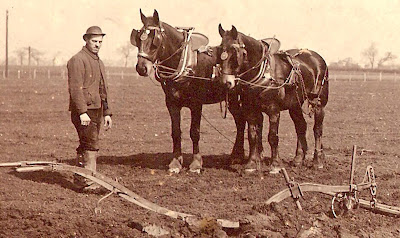Ours was a time still dominated by working animals.
For centuries the main draught animal had been the oxen and in some parts of the country their use continued well on till the end of the 19th century and the start of the twentieth.
But by the 1840s the horse had taken over in most areas.
The horse was a familiar sight here in the township. As well as working the fields, they would have pulled the carts and wagons of the farmers and carriers as well as the coaches of the well to do.
Horses provided work for the blacksmith, and the farrier and indirectly for the wheelwright. Then there were the men who worked with the horses. Of these the ploughman and the carter earned more than most other farm workers. The carter after all was assured a regular wage because horses needed to be looked after all the year round, unlike the farm labourer who could expect seasonal periods of unemployment.
But most farm workers came into some contact with horses at some point and on the smaller farms and market gardens, the job of caring and working with horses fell to the farmer or his son.
The Bailey family on the Row who farmed seven acres had just one horse which would have doubled for both ploughing and pulling the spring cart.
This would have been the pattern here with so many of our market gardens operating with less than 10 acres of land.
On our bigger farms there were men who were employed specifically to deal with the horses. James Higginbotham, farmer on the green employed a carter and at Dog House Farm just outside the township eight of the men who lived on this 380 acre farm were carters.
Here horses were worked in pairs and there might be two or three teams each with a carter and mate. The most intensive period for a working horse were sowing wheat, or turnips, carting mangels and harvest time.
Many carters formed close bonds with their horses, a bond which was deepened by the long hours they spent together.
A carter might start as early as five in the morning as the horses were prepared for work and last after the day had finished in the fields.
The horses had to be cleaned of the thick mud they had picked up and then fed, watered and groomed.
For this a carter might be paid just over £1 a week, although James Higginbotham was less generous. During the mid 1840s he was paying his carters between 4s 6d [22p] and 6s [30p] a week. But these wages reflected the fact that the men lived in and so received their food and lodging as part of their wages.
This supplement could make a difference of between 5s [25p] and 7s [35p] a week. Even given this their wages seem much lower.
From THE STORY OF CHORLTON-CUM-HARDY, Andrew Simpson, http://chorltonhistory.blogspot.co.uk/2012/10/the-story-of-chorlton-cum-hardy-new.html
Pictures; from the collections of Allan Brown, Carolyn Willitts and the Lloyd collection



No comments:
Post a Comment